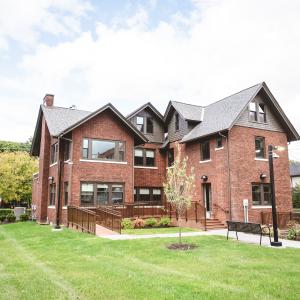Built in 1924, a 4,500-square-foot home in Cleveland’s Magnolia-Wade Park Historic District sat vacant for nearly a decade. But with a formal ribbon-cutting in October, the property—restored with a $2.3 million investment by Case Western Reserve—was reintroduced to the neighborhood as the university’s new Wade Park Community Engagement Center.
Funding for the restoration included $250,000 from The George Gund Foundation and $200,000 from the American Rescue Plan Act, directed by Cuyahoga County Council Representative Yvonne Conwell.
The repurposed home at 11310 Wade Park Ave. will now offer activities and programs for neighborhood residents and community groups.
“One of our three institutional priorities is to enhance our engagement with the surrounding community,” said Case Western Reserve President Eric W. Kaler. “This center enables us to work each day alongside local residents, fostering more robust partnerships between us and promoting more effective collaborations that will strengthen our shared neighborhood.”
Something for everyone
Case Western Reserve’s Neighborhood Advisory Council was established three years ago to advise university leadership on issues that impact people in East Cleveland and Cleveland neighborhoods near campus. The 20-member body—composed of community members, students, and representatives from CWRU and local organizations—will play a significant role in determining specific programming, including:
- Space for community residents to conduct remote job interviews or telehealth appointments;
- Health screenings and wellness workshops with CWRU’s medical, nursing and dental schools and community partners;
- Youth programs to connect CWRU student tutors with students in local elementary, middle and high schools;
- Law clinics to address a variety of needs, from reentry after incarceration to estate planning;
- Small business advising and workshops in partnership with local organizations; and
- Community gathering spaces for meetings and events.
“The center is a place where CWRU faculty, staff and students can come together with residents and community members,” said Julian Rogers, CWRU’s associate vice president of local government and community relations. “They can learn from each other while creating opportunities to enhance education, build relationships and improve outcomes.”
Originally published in the winter 2024-2025 issue of Forward Thinking magazine


